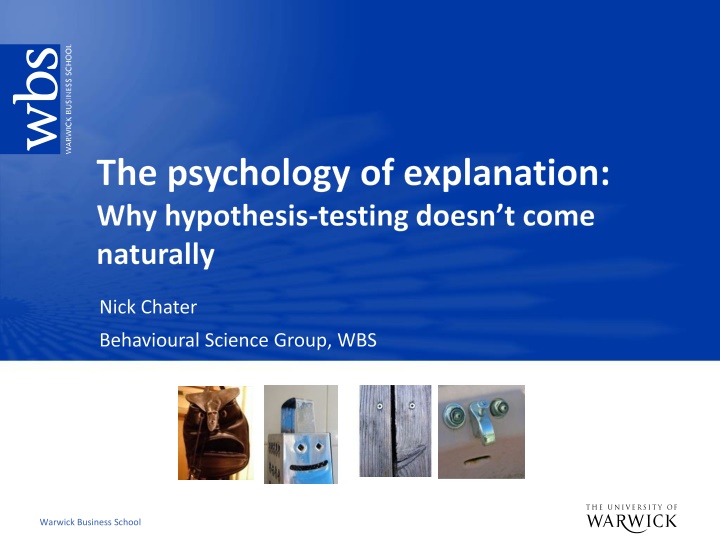
The Psychology of Explanation in Hypothesis Testing
Explore the intricacies of hypothesis testing and how it doesn't come naturally, as discussed in Nick Chater's insightful work at Warwick Business School. Delve into the cycle of thought, perception as a model for thought, and the extreme seriality of perception, shedding light on how our minds process information and make sense of the world.
Download Presentation

Please find below an Image/Link to download the presentation.
The content on the website is provided AS IS for your information and personal use only. It may not be sold, licensed, or shared on other websites without obtaining consent from the author. If you encounter any issues during the download, it is possible that the publisher has removed the file from their server.
You are allowed to download the files provided on this website for personal or commercial use, subject to the condition that they are used lawfully. All files are the property of their respective owners.
The content on the website is provided AS IS for your information and personal use only. It may not be sold, licensed, or shared on other websites without obtaining consent from the author.
E N D
Presentation Transcript
The psychology of explanation: Why hypothesis-testing doesn t come naturally Nick Chater Behavioural Science Group, WBS Warwick Business School
Overview Part 1: The cycle of thought Perception as a model for thought The extreme seriality of perception Perception = memory + metaphor The cycle of thought Part 2: Implications for the psychology of hypothesis testing I. II. III. IV. V. VI. Precedents not principles One interpretation at a time Warwick Business School
PART 1. PART 1. THE CYCLE OF THOUGHT THE CYCLE OF THOUGHT Warwick Business School
I. I. PERCEPTION AS A MODEL FOR THOUGHT PERCEPTION AS A MODEL FOR THOUGHT Warwick Business School
Effort after meaning (Bartlett, 1932) Idasawa s spikey sphere One operationalization is simplicity: choose the interpretation generating the shortest encoding of the image (Mach, Hochberg, Leeuwenberg, Chater & Vitanyi) Warwick Business School
II. II. THE EXTREME SERIALITY OF PERCEPTION THE EXTREME SERIALITY OF PERCEPTION Warwick Business School
We can only perceive one colour-map at once (Huang & Pashler, 2007) Warwick Business School
We can only perceive one colour at once! (Huang & Pashler, 2007) Task: do you see red or purple? (after brief flash) When flashed successively vs simultaneously, performance declines for colours, not locations. We load each colour serially! Warwick Business School
III. III. PERCEPTION = MEMORY + METAPHOR PERCEPTION = MEMORY + METAPHOR Warwick Business School
Vast memory for visual images, tunes, voices, etc Very high recognition accuracy Lower recognition when subtle details removed Vogt S & Magnussen S (2007) Long-term memory for 400 pictures on a common theme. Experimental Psychology, 54, 298 303. Warwick Business School
Memory for interpreted, not raw, images; the raw sensory data is immediately thrown away (cf. Christiansen & Chater, 2016) Dallenbach s figure So probably you won t remember much about this strange image Warwick Business School
until you have some clues Dallenbach s cow Warwick Business School
And now you will remember it forever Warwick Business School
Incredible flexibility of perception Suggests an ad hoc patching together of patterns, rather than a coherent generative model (e.g., these will never be created by a model of the human face) Warwick Business School
IV. IV. THE CYCLE OF THOUGHT THE CYCLE OF THOUGHT Warwick Business School
The cycle of thought Warwick Business School
With memory Warwick Business School
PART 2. PART 2. IMPLICATIONS FOR THE IMPLICATIONS FOR THE PSYCHOLOGY OF HYPOTHESIS TESTING PSYCHOLOGY OF HYPOTHESIS TESTING Warwick Business School
V V. . ONE INTERPRETATION AT A TIME ONE INTERPRETATION AT A TIME Warwick Business School
One interpretation at a time A face Warwick Business School
One interpretation at a time A word Warwick Business School
One interpretation at a time A face or a word, but not both at once Warwick Business School
The one-interpretion limit applies to abstract thinking too Johnson-Laird: one-model thinking as the fundamental human reasoning error We interpret our data in terms of our current model, and then throw away the data So we tend to get locked in Festinger et al (1956) So not much active hypothesis testing Warwick Business School
VI. VI. PRECEDENTS NOT PRINCIPLES PRECEDENTS NOT PRINCIPLES Warwick Business School
Hypothesis testing or other sophisticated statistics is needed to augment everyday thought 1. Requires hard mental work to isolate specific hypotheses (e.g., our assumptions) And we are bad at working out what our assumptions are (cf AI) 2. Let alone experimentally test them (between) them nb. experimental science only since the Renaissance) 3. Or do any statistical analysis Even the need for statistics only slowly appreciated from late C19 onwards The mind is more na ve lawyer than na ve scientist Warwick Business School
The brain fits a loose, non-parametric model, rather than testing hypotheses Which accumulates precedents, but doesn t distill principles And hypothesis-testing is cognitively unnatural We don t normally explicit consider multiple alternatives But thought proceeds by enriching our existing instance- based model of the world We need a experimental and statistical methodology precisely to combat our mental frailties Warwick Business School
